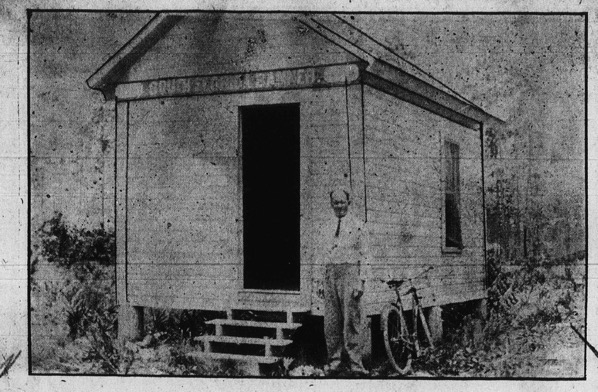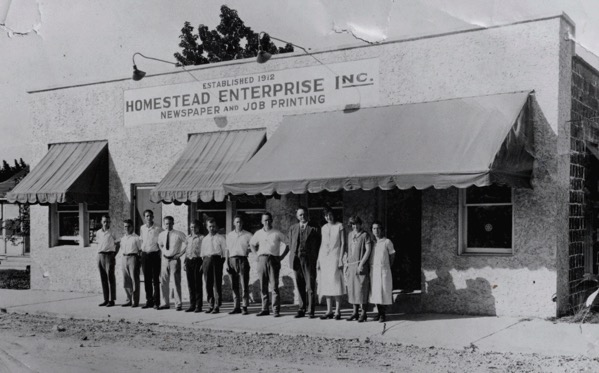The following article appeared in the October 3, 1918 issue of the Homestead Enterprise and is re-published here because it will be of interest to many of you who subscribe to posts.
The descendants of Charles H. Gossman married into the Caves, Chambers, Aman and Vihlen families, among others. The Gossman homesteads were on the east side of Tennessee Road between Coconut Palm and Silver Palm Drives. Henry claimed his first, on November 30, 1897 and Charles claimed his on February 8, 1898. Henry proved up on August 11, 1903 and Charles on August 13, 1903.
If anyone should ask me what induced me to come to South Dade in 1900 the answer would be that I got tired of working on the construction gang for the F.E.C. and wanted to get a homestead for myself, before the best locations were taken. My job on the railroad took me away from home a good deal of the time, and that is why I wanted to locate a home where I would be near to my work.
In those early days George Land, a real estate agent of Miami, used to charge prospective settlers $5 to show them the best land open for location. The price was very reasonable, for Mr. Land was in a position to give the best advice in addition to acting as a guide. And was a guide needed? Well, I guess so. There were no roads, buildings or anything of the kind that would answer as a landmark then. Everything looked alike, and the prospector who strayed far without a compass stood a good chance of getting lost. All of the oldtimers knew what it was like to lose their bearings in those days. Even nowadays it isn’t a hard job to get lost in the everglades, a fact which is proven by recent events.
With Mr. Land as our guide we decided to make a ten-day trip to our homestead-to-be. Well, it was ten days and then some. The first thing to do was to stock up with provisions at the store at Cutler then kept by G. W. Moody, who later moved to Naranja.1 The stuff was loaded on a wagon and we had some sort of a road from Cutler to Black Creek;2 that is, we called it a road then, but after leaving that place it was a case of toting the balance of the journey. In crossing the prairie, the going was fairly good, providing there was not too much water. In case everything was afloat, as often happened, we had to push ahead and take chances on not getting bogged. Sometimes we made a bad guess and then there was trouble. Lots of things we thought very serious then we laugh at now.
Arriving at our destination we put up a tent picnic fashion and proceeded to enjoy life while our teamster returned to Cutler with the promise to return for us at the end of ten days. I don’t know whether the teamster got enough of it on the first trip or not — anyway he failed to return and so we had to start back without him.
Here’s where we bumped into some real trouble. We had our three boys with us then — Walter, who is now 24; Jesse, 26; and Adolph, 18. Adolph and Walter are now in Uncle Sam’s navy, fighting to down the huns, while Jesse is in France with the army. These lads were little fellows then, the oldest being only eleven, and they had to be helped along the journey by the older folks. It was a tough journey from our homestead to Cutler and part of the time we were afraid we would not reach the journey’s end that day. Fourteen miles is not a long day’s journey, under fair conditions, but think what we had to endure in traversing the rough trail and equally rough road, as well as the glades that were wet and muddy, and in places almost impassible. When we finally reached Cutler the party was about all in, and Mrs. Gossman said then that she never wanted to see or hear of that wild country again. Now, with our fine grove of 17 acres, our comfortable home and well-stocked farm, she says she would be the happiest woman in Florida if only the war were ended and her three boys were back on the homestead.
The following May we moved down to our homestead with a party composed of Will Anderson,3 Tom Jones, “Dad” Osborne, Walter Tweedell4 and his brother. We had the task of clearing C. W. Hill’s land5 and this was the job on which the party was to work. That winter we put two acres and a half in tomatoes from which we netted $1650,6 to our great surprise and delight. We packed the crop ourselves and delivered the tomatoes to Cutler, from which they were taken by boat to Miami. At that time there was no other way to reach Cutler except by water. The motorboat hadn’t made it’s (sic) appearance in these waters then and so we were compelled to depend on sailboats to transport our produce to Miami.
Our nearest neighbors were the Slavin brothers7 who lived at Black Point, seven miles away.8 But they were good neighbors at that and helped us out of a serious difficulty one time, when we were bogged on the glades.
Our first house was built of sawed lumber and was fairly comfortable, though rough. The material was hauled from Cutler by Will Anderson, 500 feet at a time. As my wife worked with me in the construction we used up the material faster than Mr. Anderson could get it to us. The first building was 20×22, two stories high, to which, six years ago, we added a new addition which gave us a roomy and homelike house.
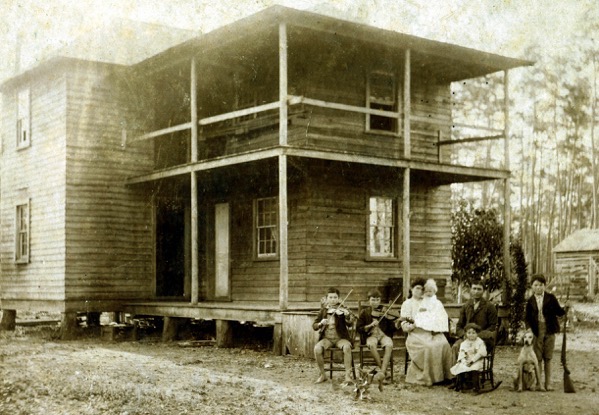
Began putting in my grove the second year and have kept adding to it ever since. Grapefruit and oranges are my mainstay.
There were no schools here in those early days, but three years after our arrival a small school with only ten pupils was started. Great improvements have since been made in this respect as is shown by our fine new Farm Life School which is only a short distance from our home.
When “Uncle Nick”10 came to our section he said he was going to put out a crop of beans, and he was advised not to do this as the deer, which were very plentiful then, would eat his crop before he had a chance to harvest it. But “Uncle Nick” said he would play a foxy trick on the deer. So he built a little shack for cover and when night came he was to lay in wait for the deer, armed with his trusty gun and a determination to kill any deer that tried to eat his beans. Getting under cover one dark night he watched and waited as patiently as he could for deer, but none came. Yet, when the sun arose, lo! and behold the beans were all neatly cropped to the ground by the deer, their tracks being seen everywhere. “Uncle Nick” solemnly declared he never slept a wink all night, but some of the boys say the sandman came along about midnight and threw a handful or so his way, and that was all there was to it. Be that as it may, the bean crop was gone. Also the venison that “Uncle Nick” liked as well then as he does today.
As I said, the deer were plentiful then. I have seen as many as a dozen at one time, all within easy rifle range. The Indians used to come here for the purpose of getting game and often camped on our land. They were good neighbors, but pretty thrifty beggars at that. We used to like them though. In fact, human beings of any description were welcomed when our numbers were so few.
But shortly after we came to our homestead new-comers began to drop in, locate their claims, and prepare to establish permanent homes. This made it pleasant for us. At one time all our provisions came from Cutler, fifteen miles away. Then gradually more stores were started, some of which were comparatively close. Then came churches and schools, and more of the refinements of civilization.
Pioneer life is rough and has many privations, but we enjoyed the early days because of the promise they gave of the future. While we look with pleasure on the past, and are content with the present and the prospects for the future, we think, had we known all there was in store for us we would have hesitated in making the first steps, although the outcome has been as favorable as it is.
______________________________________________________________________
Article revised and photograph added on August 31, 2019.

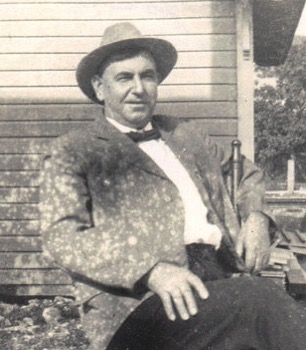
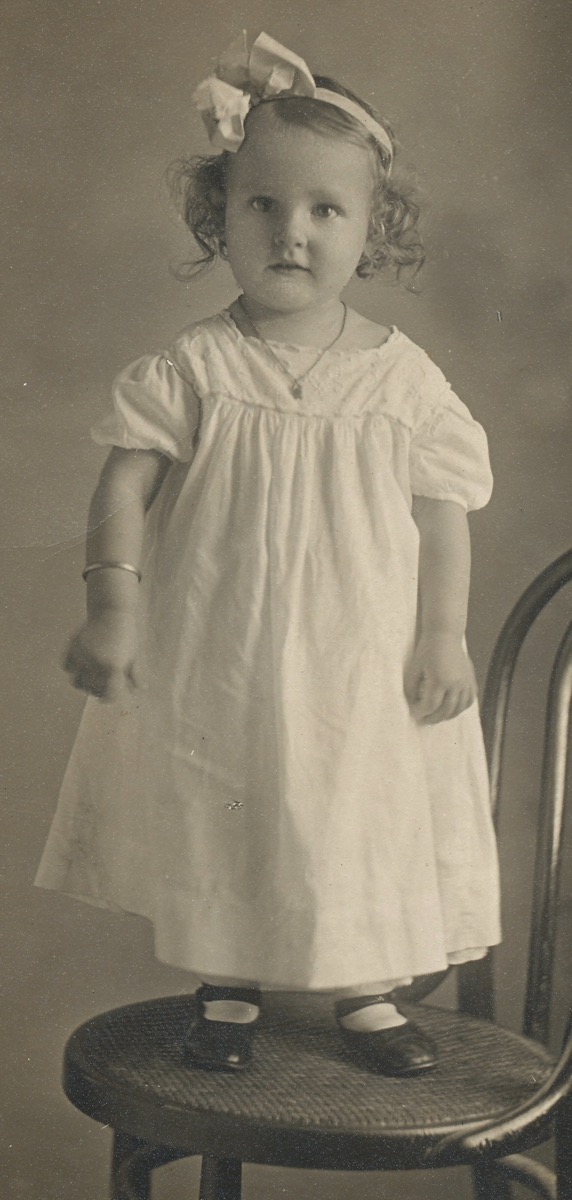 Myoma Kahl at the age of about 2
Myoma Kahl at the age of about 2